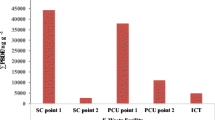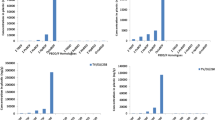Abstract
Plastic waste of electrical and electronic equipment (WEEE) can contain polybrominated diphenyl ethers (PBDEs) that have been used as fire retardants for a long time. PBDEs were listed in the Stockholm Convention as persistent organic pollutants, so PBDE-containing plastic waste should be separated and disposed of in an ecologically sound manner. In the article, the results of bromine and PBDE content in plastic samples of WEEE collected in Belarus are presented. The screening method for bromine identification and HRGC/HRMS for PBDE identification were applied. It is shown that bromine is present in 43% of the 111 studied samples. Most often, Br-containing plastic was found in CRT monitor, CRT TVs and LCD monitor (about 50%), printers (35%), and LCD TVs (25%). PBDEs were revealed in 12 Br-containing samples, representing TVs, monitors, and printers. The sum of ∑10PBDEs varied from 6.6 to 21,000 μg/kg. BDE-209 dominated in 9 samples (75% of cases); BDE-183, in two; and BDE-47 and BDE-99, in one sample. Based on the low content of PBDEs in the plastic, year of equipment production, and year of restriction of PBDEs applied in the countries-manufacturers, it was concluded that the presence of PBDEs in plastic is a consequence of contaminated waste recycling. Despite the relatively low concentrations of PBDEs (below the limit values established by the Stockholm and Basel conventions for POP wastes), further research is necessary with an extension of the list of analyzed types of equipment and identification of other brominated flame retardants.
Similar content being viewed by others
References
Baldé CP, Forti V, Gray V, Kuehr R, Stegmann P (2017) The Global E-waste Monitor – 2017, United Nations University (UNU), International Telecommunication Union (ITU) & International Solid Waste Association (ISWA), Bonn/Geneva/Vienna
Bayarmaa B, Gan-Erdene T, Weber R, Jargalsaikhan L (2014) Analysis of polybrominated diphenyl ether and tetrabromobisphenol A in plastic samples in Mongolia. Mongolian J Chem 15(41):27–32
Chen Y, Li JH, Chen LQ, Chen SS, Diao WH (2012) Brominated flame retardants (BFRs) in waste electrical and electronic equipment (WEEE) plastics and printed circuit boards (PCBs). Procedia Environ Sci 16:552–559. https://doi.org/10.1016/j.proenv.2012.10.076
Cristale J, Hurtado A, Gómez-Canela C, Lacorte S (2016) Occurrence and sources of brominated and organophosphorus flame retardants in dust from different indoor environments in Barcelona, Spain. Environ Res 149:66–76. https://doi.org/10.1016/j.envres.2016.05.001
EAEU TR 037/2016 (2016) Technical Regulation of the Eurasian Economic Union On the Limitation of the Use of Hazardous Substances in Electrical and Electronics Products, N113, October 18, 2016. Available at: http://docs.cntd.ru/document/420387089 (in Russian). Accessed 03.02.2017
ECHA (2012) European chemicals agency. Annex XV dossier. Proposal for identification of a PBT/vPvB substance. Bis(pentabromophenyl)ether (decabromodiphenyl ether; decaBDE). July 2012-final. Submitted by the United Kingdom, http://echa.europa.eu/documents/10162/13638/SVHC_AXVREP_pub_EC_214_604_9_decabromodiphenylether_en.pdf Accessed 18.09.2015
ECHA (2014) Multiple Framework Contract with re-opening of competition for scientific services for ECHA. Support to an annex XV dossier on bis-(pentabromophenyl) ether (decaBDE). Final report. European chemicals agency. https://echa.europa.eu/documents/10162/13641/annex_xvi_consultant_report_decabde_en.pdf. Accessed 25.05.2017
Gallen C, Banks A, Brandsma S, Baduel C, Thai P, Eaglesham G, Heffernan A, Leonards P, Bainton P, Mueller JF (2014) Towards development of a rapid and effective non-destructive testing strategy to identify brominated flame retardants in the plastics of consumer products. Sci Total Environ 491–492:255–265
Gavilán-García I, Beristain-Montiel E, Tovar-Gálvez LR, Gavilán-García A (2016) Determination of PBDEs in e-waste polymers from two solid waste landfills in Mexico. Environ Earth Sci 75(20):October 2016. https://doi.org/10.1007/s12665-016-6144-x
Harrad S, Hazrati S, Ibarra C (2006) Concentrations of polychlorinated biphenyls in indoor air and polybrominated diphenyl ethers in indoor air and dust in Birmingham, United Kingdom: implications for human exposure. Environ Sci Technol 40(15):4633–4638. https://doi.org/10.1021/es0609147
Ilankoon IMSK, Yousef G, Nan CM, Gamini H, Thandazile M, Jochen P (2018) E-waste in the international context – a review of trade flows, regulations, hazards, waste management strategies and technologies for value recovery. Waste Manag 82:258–275. https://doi.org/10.1016/j.wasman.2018.10.018
IVM (2013) POP STREAM. POP-BDE waste streams in the Netherlands: analysis and inventory. A joint IVM-IVAM report/ Leslie HA, Leonards PEG, Brandsma SH, Jonkers N. Report R13–16. 17 December 2013. 90 p. http://pops-and-waste.bipro.de/wp-content/uploads/2018/04/Netherlands_POPRC8_SUBM_BDE_PFOS_Netherlands_20180410.pdf. Accessed 05.03.2018
Jin M, Yin J, Zheng Y, Shen X, Li L, Jin M (2018) Pollution characteristics and sources of polybrominated diphenyl ethers in indoor air and dustfall measured in university laboratories in Hangzhou, China. Sci Total Environ 624:201–209. https://doi.org/10.1016/j.scitotenv.2017.12.117
Klinčić D, Dvoršćak M, Jagić K, Mendaš G, Romanić SH (2020) Levels and distribution of polybrominated diphenyl ethers in humans and environmental compartments: a comprehensive review of the last five years of research. Environ Sci Pollut Res 27:5744–5758. https://doi.org/10.1007/s11356-020-07598-7
Kukharchyk T, Chernyuk V (2019) Formation of electronic and electrical equipment waste, potentially containing polybromdiphenyl ethers. In: Batyan AN, Maskevich SA, Poznyak SS et al (eds) Belarus and problems of their regulation. Sakharov readings 2019: environmental problems of the XXI century. Proceedings of the 19th International Scientific Conference, May 23–24, 2019, Minsk, Republic of Belarus: A. D. Sakharov BSU. Information Center of the Ministry of Finance, 2019. V.3. P. 63–66, Minsk http://elib.bsu.by/handle/123456789/231553
Lassen C, Jensen AA, Crookes M, Christensen F, Jeppesen CN, Clausen AJ, Mikkelsen SH (2014) Survey of brominated flame retardants The Danish Environmental Protection Agency Environmental Project No 1536
Li Y, Li J, Wang L (2013) Recycling of PBDEs containing plastics from waste electrical and electronic equipment (WEEE): A review. Conference paper on the IEEE 10th International Conference on e-Business Engineering. September 2013. 407-412. DOI: https://doi.org/10.1109/ICEBE.2013.62
Li J, Chen Y, Wenjing X (2015) Polybrominated diphenyl ethers in articles: a review of its applications and legislation. Environ Sci Pollut Res 24:4312–4321. https://doi.org/10.1007/s11356-015-4515-6
Li W, Ma W, Jia H, Hong WJ, Moon HB, Nakata H, Minh NH, Sinha RK, Chi KH, Kannan K, Sverko E, Li YF (2016) Polybrominated diphenyl ethers (PBDEs ) in surface soils across five asian countries : levels, spatial distribution and source contribution. Environ Sci Technol 50(23):12779–12788. https://doi.org/10.1021/acs.est.6b04046
Li Y, Chang Q, Luo Z, Zhang J, Liu Y, Duan H, Li J (2020) Transfer of POP-BFRs within e-waste plastics in recycling streams in China. Sci Total Environ 717:135003. https://doi.org/10.1016/j.scitotenv.2019.135003
Morf LS, Tremp J, Gloor R, Huber Y, Stengele M & M.Zennegg (2005) Brominated flame retardants in waste electrical and electronic equipment: substance flows in a recycling plant. Environ Sci Technol 39, 5: 8691–8699, doi: https://doi.org/10.1021/es051170k
Norwegian Environment Agency (2015) Literature Study. (2015) DecaBDE in waste streams. Final Report. Reference number: 2015/10094 Norwegian Environment Agency
Operator of secondary resources (2019) About the volumes of collection and use of secondary material resources, the sizes and directions of spending funds received from manufacturers and suppliers in 2018. State institution “Operator of secondary material resources”. Report for 2018 [Electronic resource]. - Access mode: https://vtoroperator.by/sites/default/files/operator_2018.pdf
PACE (2019) A New Circular Vision for Electronics. Time for a Global Reboot. PACE. In support of the United Nations E-waste Coalition. World Economic Forum Switzerland. www.weforum.org
Park JE, Kang YY, Kim WI, Jeon TW, Shin SK, Jeong MJ, Kim JG (2014) Emission of polybrominated diphenylethers (PBDEs) in use of electric/electronic equipment and recycling of e-waste in Korea. Sci Total Environ 1(470-471):1414–1421. https://doi.org/10.1016/j.scitotenv.2013.07.129
Puype F, Samsonek J, Vilímková V, Kopečková Š, Ratiborská A, Knoop J, Egelkraut-Holtus M, Ortlieb M, Oppermann U (2017) Towards a generic procedure for the detection of relevant contaminants from waste electric and electronic equipment (WEEE) in plastic food-contact materials: a review and selection of key parameters. Food Additives & Contaminants: Part A 34(10):1767–1783. https://doi.org/10.1080/19440049.2017.1332430
Schlummer M, Gruber L, Maurer A, Wolz G, Eldik R (2007) Characterisation of polymer fractions from waste electrical and electronic equipment (WEEE) and implications for waste management. Chemosphere 67:1866–1876. https://doi.org/10.1016/j.chemosphere.2006.05.077
Sindiku O, Babayemi J, Osibanjo O, Schlummer M, Schluep M, Watson A, Weber R (2015) Polybrominated diphenylethers listed as Stockholm convention POPs, other brominated flame retardants and heavy metals in e-waste polymers in Nigeria. Environ Sci Pollut Res Int 22(19):14489–501. doi: https://doi.org/10.1007/s11356-014-3266-0
Straková J, DiGangi J, Jensen GK (2018) Toxic LOOPHOLE: Recycling Hazardous Waste into New Products/ Arnika
Tasaki T, Takasuga T, Osako M, Sakai SI (2004) Substance flow analysis of brominated flame retardants and related compounds in waste TV sets in Japan. Waste Manag 24:571–580. https://doi.org/10.1016/j.wasman.2004.02.008
Taurino R, Pozzi P, Zanasi T (2010) Facile characterization of polymer fractions from waste electrical and electronic equipment (WEEE) for mechanical recycling. Waste Manag 30:2601–2607. https://doi.org/10.1016/j.wasman.2010.07.014
UNEP (2015) Guidance for the inventory of polybrominated diphenyl ethers (PBDEs) listed under the Stockholm Convention on Persistent Organic Pollutants. Draft. Revised March 2015 UNEP/POPS/COP.7/INF/27. http://chm.pops.int/Implementation/ IndustrialPOPs/BDEs/Guidance/tabid/5374/Default.aspx. Accessed 15.10.2016
UNEP (2017a) Guidance on best available techniques and best environmental practices for the recycling and disposal of articles containing polybrominated diphenyl ethers (PBDEs) listed under the Stockholm convention, updated January 2017 (re-issued for technical reasons in march 2017). http://chm.pops.int/Implementation/NIPs/Guidance/ GuidanceonBATBEPfortherecyclingofPBDEs/tabid/3172/. Accessed 25.11.2017
UNEP (2017b) Draft guidance on sampling, screening and analysis of persistent organic pollutants in products and articles. http://chm.pops.int/Implementation/NationalImplementationPlans/ GuidanceArchive/guidanceonsampling,screeningofPOPs/tabid/5333/Default.aspx. Accessed 25.11.2017
UNEP (2017c) Stockholm Convention On Persistent Organic Pollutants (Pops). Texts and Annexes. Revised in 2017. http://chm.pops.int/TheConvention/Overview/TextoftheConvention/tabid/2232/Default.aspx. Accessed 02.02.2020
UNEP (2019) Technical guidelines on the environmentally sound management of wastes consisting of, containing or contaminated with hexabromodiphenyl ether and heptabromodiphenyl ether, or tetrabromodiphenyl ether and pentabromodiphenyl ether or decabromodiphenyl ether. Addendum. Conference of the Parties to the Basel Convention on the Control of Transboundary Movements of Hazardous Wastes and Their Disposal. Fourteenth meeting. Geneva, 29 April–10 May 2019. UNEP/CHW.14/7/Add.3 http://www.brsmeas.org/2019COPs/MeetingDocuments/tabid/7832/language/en-US/Default.aspx. Accessed 10.10.2019
Vojta Š, Bečanová J, Melymuk L, Komprdová K, Kohoutek J, Kukučka P, Klánová J (2017) Screening for halogenated flame retardants in European consumer products, building materials and wastes. Chemosphere. 168:457–466. doi: 10.1016/j.chemosphere.2016.11.032. Epub 2016 Nov 14
Wäger P A, Schluep M, Müller E (2010) RoHS substances in mixed plastics from waste electrical and electronic equipment. St. Gallen, Switzerland: Swiss Federal Laboratories for Materials Science and Technology (Empa). http://ewasteguide.info/files/Waeger_2010_ Empa-WEEEForum.pdf. Accessed 07.09.2015
Zennegg M, Schluep M, Streicher-Porte M, Lienemann P, Haag R, Gerecke A (2013) Formation of PBDD/F from PBDE in electronic waste in recycling processes and a test extruder. Sixth International Symposium on Flame Retardants, April, 2013, San Francisco, California
Zhou XY, Guo J, Lin KF, Huang K, Deng JJ (2013) Leaching characteristics of heavy metals and brominated flame retardants from waste printed circuit boards. J Hazard Mater 246:96–102. https://doi.org/10.1016/j.jhazmat.2012.11.065
Funding
This work/part of the work was carried out with the support of core facilities of RECETOX research infrastructure, project number LM2015051, funded by the Ministry of education, youth and sports of the Czech Republic under the activity “Projects of major infrastructures for research, development and innovations.”
Author information
Authors and Affiliations
Contributions
Tamara Kukharchyk contributed to the study conception and design. Sampling and sample preparation, data collection, and analysis were performed by Vladimir Chernyuk. Chemical analytical work and methods description were performed by Petra Přibylová. The first draft of the manuscript was written by Tamara Kukharchyk and all authors commented on previous versions of the manuscript. All authors read and approved the final and revised manuscript.
Corresponding author
Additional information
Responsible Editor: Hongwen Sun
Publisher’s note
Springer Nature remains neutral with regard to jurisdictional claims in published maps and institutional affiliations.
Rights and permissions
About this article
Cite this article
Kukharchyk, T., Přibylová, P. & Chernyuk, V. Polybrominated diphenyl ethers in plastic waste of electrical and electronic equipment: a case study in Belarus. Environ Sci Pollut Res 27, 32116–32123 (2020). https://doi.org/10.1007/s11356-020-09670-8
Received:
Accepted:
Published:
Issue Date:
DOI: https://doi.org/10.1007/s11356-020-09670-8




